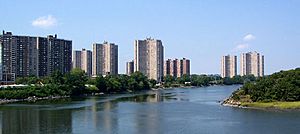East Bronx facts for kids

The East Bronx is a big part of the Bronx in New York City. It's located on the eastern side of the borough, stretching from the Bronx River all the way to the coast. This area is home to many different neighborhoods.
Some of the neighborhoods you'll find here include Harding Park, Soundview, Castle Hill, Parkchester, Westchester Square, Edgewater Park, Van Nest, Pelham Parkway, Morris Park, Throggs Neck, Country Club, City Island, Pelham Bay, Williamsbridge, Eastchester, Baychester, Edenwald, Wakefield, Bronx, and Co-op City.
Contents
East Bronx vs. West Bronx
The East Bronx is different from the West Bronx in a few ways. It's generally flatter and closer to the water, much like the nearby borough of Queens. The West Bronx, on the other hand, is older and has more hills.
Another interesting difference is when these areas became part of New York City. The West Bronx joined the city earlier, in 1874. The East Bronx became part of New York City later, in 1895. Before that, it was part of Westchester County.
Street Names and Numbers
Unlike the West Bronx, the East Bronx doesn't have many numbered streets. Most of its streets have names that are specific to their neighborhoods.
It's important to know that the Bronx uses the same street numbering system as Manhattan. This means that some streets called "East" (like East 161st Street) might actually be west of the Bronx River. This is because the dividing line for "East" and "West" streets is Fifth Avenue in Manhattan and Jerome Avenue in the Bronx.
People and Cultures
The East Bronx is a vibrant place with many different cultures.
Historically, many Italian American families have lived here. They are still a large group in neighborhoods like Morris Park, Pelham Bay, Pelham Gardens, Throggs Neck, Country Club, and City Island.
The North East Bronx has a big Black Caribbean population. You'll find many people from this background in Wakefield, Baychester, and Edenwald.
Parkchester is known for its large Asian American community. This includes people from Bangladesh, Pakistan, and China. While the Asian population is significant, the Hispanic population is even larger, mostly made up of Puerto Ricans.
Throughout the East Bronx, you'll find many Hispanic Americans. People of Puerto Rican and Dominican heritage are the majority in Soundview, Castle Hill, Parkchester, Westchester Square, and Van Nest.
Albanians also have a presence across the East Bronx. They are especially notable in Van Nest, Morris Park, and Pelham Parkway.
How People See the Bronx
For a long time, people in New York City thought of the Bronx as having two main parts: the East Bronx and the West Bronx. This made sense because of their history and culture.
However, starting in the 1960s, some areas in the southwestern Bronx faced challenges. Because of this, people began to see the borough as split into "The South Bronx" and "everywhere else."
Today, the idea of the "South Bronx" isn't as common. The challenges that area faced have improved a lot since the 1970s.
Images for kids



